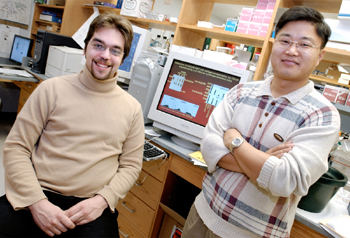
Aleksandar Stanic and Jang-June Park, both graduate students in Immunology & Microbiology, are primarily responsible for the reported genetic and biochemical findings. (photo by Dana Johnson)
VUMC team closes in on immune cell activation
A unique group of immune cells that act as sentinels in the body’s defense against foreign invaders exist in a perpetual state of heightened alert. Provocation of these cells launches a rapid and robust rallying of other elements of the immune system to contain the danger.
Scientists at Vanderbilt University Medical Center are one step closer to identifying the antigen that triggers activation of these so-called natural killer T cells, a finding that could lead to therapeutic control of when and where the cells sound their alarm. NKT cells are known to be depleted in certain immune-related diseases, including diabetes and HIV/AIDS.
Through their studies in mice and cultured cells, the researchers, led by principal investigator Sebastian Joyce, Ph.D., have implicated a glycolipid molecule, known as beta-D-glucosylceramide, or beta-D-GlcCer, in the generation and/or presentation of the elusive NKT antigen. The findings appear in the Feb. 18 Proceedings of the National Academy of Sciences.
Why put so much effort into identifying the naturally occurring NKT antigen? The work is important, Joyce says, because of the extent to which NKT cells control regulation of the immune system as a whole. Moreover, NKT cells and the system for activating them are highly conserved in most species studied, including humans.
NKT cells are thought to play a key role in immunity to pathogens and tumors. Once activated, the cells produce a burst of stimulatory molecules, called cytokines, that jump-start other cellular and non-cellular components of the immune system. The resulting flurry of cross talk links elements from both innate and adaptive immune responses in a comprehensive assault that can occur only after an initiating interaction between the presented antigen and the NKT cell receptor. Presentation of the antigen occurs on the surface of other specialized cells circulating in the body, via a molecule called CD1.
“Because this special T cell is so important, we are trying to understand how they develop and how they are activated,” said Joyce, associate professor of Microbiology and Immunology. “We (immunologists) talk about antigen loading and antigen presentation, but we really know very little about those events. So we are trying to both biochemically and genetically understand CD1, the binding of antigen to CD1, and the presentation of the CD1-antigen complex to NKT cells.”
The scientists investigated a number of candidate glycolipids for their ability to trigger NKT cell activation. Previous evidence had shown that the marine sponge-derived lipid alpha-D-galactosylceramide (alpha-D-GalCer) is capable of activating a strong anti-tumor response in mouse NKT cells, but no chemical equivalent of this molecule has been found in mammals. However, the beta form of the glycolipid — beta-D-GalCer — does occur.
The scientists found that if the gene responsible for beta-D-GalCer is knocked out in mice, the mice are born successfully, but die in the first few days of postnatal development.
“In those animals, we found that there were no problems in either NKT cell development or in NKT antigen presentation,” said Aleksandar Stanic, fourth-year physician-scientist in training and lead author of the paper. “That led us to rule out beta-D-GalCer as essential in the process.”
On the other hand, when the researchers looked at a similar glycolipid, beta-D-glucosylceramide, or beta-D-GlcCer, they found a different story.
In cell lines that were equipped for normal antigen presentation but were unable to synthesize beta-D-GlcCer, they found that NKT cells could not be activated. Repair of beta-D-GlcCer synthesis in these cell lines restored normal NKT cell immune response. The possibility that beta-D-GlcCer is itself the natural antigen was excluded, however, because it was unable to trigger activation in specialized cell-free antigen-presentation assays.
Taken together, Joyce says, these findings suggest that beta-D-GlcCer is not the sought after NKT cell antigen, but it is somehow instrumental in the process of glycolipid antigen presentation by CD1.
“We’ve only just scratched the surface of it,” says Joyce, “but the work suggests that the antigen could be a glycolipid derived from beta-D-GlcCer, or it could be that beta-D-GlcCer is involved in the loading of the antigen onto CD1. We need to do biochemical analyses to distinguish between these possibilities, and that’s what comes next.”
Other current and former Vanderbilt researchers contributing to the paper include A. Dharshan De Silva, Jang-June Park, and Luc Van Kaer, all from the department of Microbiology and Immunology.
The work was funded by the National Institutes of Health, the Juvenile Diabetes Research Foundation, and the Human Frontiers in Science Program.













